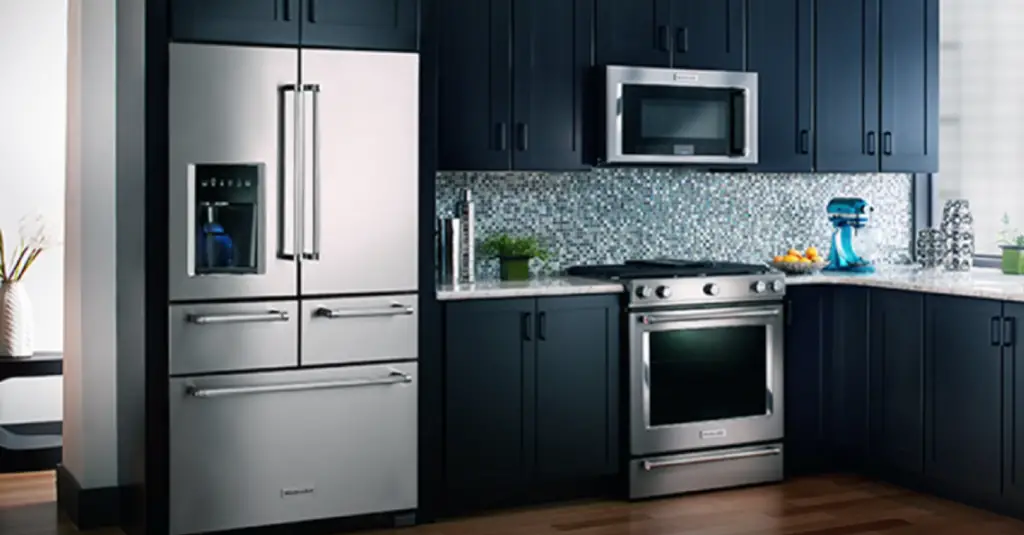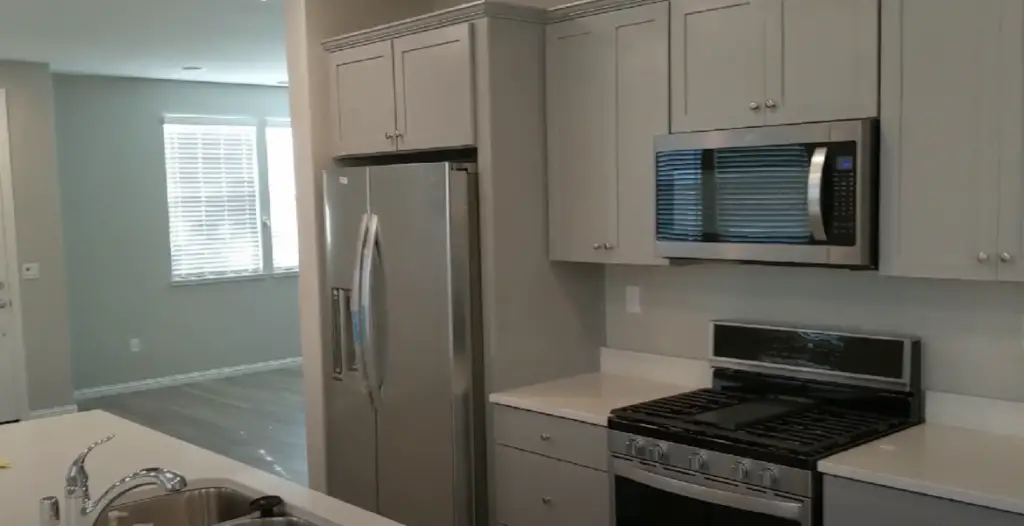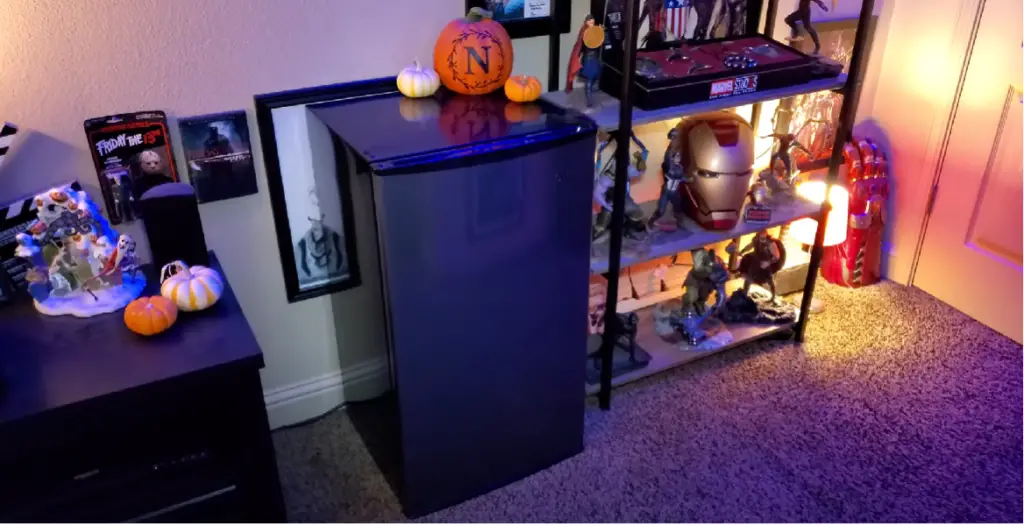Many homeowners often find themselves wondering, “Can I put a refrigerator on the carpet?” This question arises due to concerns about safety, appliance performance, and the longevity of both the carpet and the refrigerator. While it might seem like a simple decision to place a refrigerator on a carpeted surface, there are several factors to consider. This article aims to provide a comprehensive guide on this subject, offering practical insights and advice to homeowners.
How do I protect my carpet from fridge damage?
Using Appliance Mats
One effective way to protect your carpet from fridge damage is by using appliance mats. These mats are designed to bear the weight of heavy appliances like refrigerators, preventing them from sinking into the carpet and causing depressions. They also help distribute the weight of the fridge evenly, which can prevent damage to the carpet fibers. Additionally, these mats are often water-resistant, offering an extra layer of protection in case of any leaks or spills from the fridge. Appliance mats come in various sizes and can be easily trimmed to fit underneath your refrigerator.

Cleaning and Vacuuming Regularly
In addition to using an appliance mat, regularly cleaning and vacuuming the area beneath your refrigerator is another important step in protecting your carpet. This will help to reduce any dirt or dust build-up, ensuring that your carpet stays clean for longer. Additionally, it’s also essential to check for signs of wear and tear on the carpet, such as any rips or tears that may have been caused by the weight of the fridge. If you notice any damage, it’s important to take steps to address this promptly.[1]

Can You Put a Fridge on Hardwood Floors?
Putting a refrigerator on hardwood floors can be risky, as they are better suited to lighter appliances like washing machines and dishwashers.

Additionally, it’s important to use an appliance mat on any type of floor surface, as this will help distribute the weight of the refrigerator evenly and reduce the risk of damage.
Is it safe to put a refrigerator on a carpeted floor?
It is generally safe to put a refrigerator on a carpeted floor, provided certain precautions are taken. Carpet allows for some dispersion of the fridge’s weight, reducing pressure on a specific area, which can be beneficial. However, carpets can also retain heat, which might cause the refrigerator’s motor to overheat if it’s not properly ventilated.

Carpet fibers can also get sucked into the fridge, causing the coils to get dirty faster, which can affect the appliance’s performance over time. Regular cleaning is recommended to prevent this. In the case of a water leak, it could be more problematic on a carpet than on a hard surface, as carpets can absorb water, leading to potential mildew or mold issues. To prevent this, use a water-resistant mat under the fridge.
Tips for Placing a Fridge on a Carpeted Floor
Use an appliance mat: As stated previously, an appliance mat can safeguard your carpet from potential damage and is especially recommended for heavy appliances like refrigerators.
Ensure proper ventilation: Ensure your refrigerator is not pushed entirely against the wall. Leave adequate space for airflow, particularly around the condenser coils at the back. This is critical to prevent overheating and ensure efficient operation.
Regular cleaning: Regularly vacuum and clean under and around your fridge. This will help to minimize dust and dirt buildup that could get sucked into the fridge and hamper its performance.

Check for leaks: Regularly inspect your refrigerator for any signs of leaks. In the event of a leak, carpets can absorb the water, which can lead to mildew or mold problems if not promptly addressed.
Professional installation: If possible, consider having your refrigerator installed by a professional. They can ensure that it is properly set up and placed in a way that minimizes potential damage to your carpet.
Regular inspection: Regularly inspect your carpet for any signs of wear and tear underneath the fridge. If you notice any damage, take steps to address it immediately to prevent further deterioration.
By following these tips, you can safely enjoy the convenience of having your refrigerator on a carpeted surface while minimizing potential risks and damage.[4]
Other things to avoid when placing a fridge
Avoid Direct Sunlight: Placing your refrigerator in direct sunlight can cause it to work harder to maintain its internal temperature, leading to increased energy consumption and potentially premature failure.

Avoid Unstable Surfaces: The flooring under a fridge should be level and sturdy. An unstable or uneven surface can cause the fridge to rock, potentially leading to spills inside the appliance or even damaging the refrigeration system.
Avoid Tight Spaces: A refrigerator needs room to ventilate. Placing it in a tight space or corner can impact the efficiency of the appliance and could cause the motor to overheat.
Avoid Placing Near Heat Sources: Position your fridge away from stoves, ovens, or other heat-generating appliances. These heat sources can cause your fridge to work harder to stay cool, which can increase your energy bill and potentially reduce the lifespan of your fridge.
Avoid Placing Items on Top: While it might be tempting to use the top of the fridge for extra storage, it’s best to keep this area clear. Items stored above can restrict airflow and cause the fridge to overheat. In addition, they can also pose a safety risk if they fall.
By avoiding these common pitfalls, you can ensure your refrigerator runs efficiently and lasts for many years.[2]
FAQ
What is the ideal covering for a refrigerator?
The ideal covering for a refrigerator is an appliance mat. An appliance mat is designed to bear the weight of heavy appliances like refrigerators, effectively protecting the flooring underneath from potential damage. It also helps distribute the weight of the refrigerator evenly, reducing pressure on a specific area. Moreover, appliance mats are usually water-resistant, providing an added layer of protection in case of leaks. Some mats even have anti-vibration properties, reducing noise and vibration from the refrigerator. So, it’s an effective and easy solution to protect both your refrigerator and the surface it stands on.
Is it safe to put a fridge on tile?
Yes, it is safe to put a refrigerator on tile when done properly. It’s important to use an appliance mat in order to distribute the weight evenly and reduce the risk of damage. Additionally, ensure there is adequate space around the fridge for airflow, specifically at the back where the condenser coils are located. Regular inspection and cleaning of the tile flooring is also recommended in order to prevent dust or dirt from getting sucked into the appliance. Following these tips will help you safely enjoy the convenience of a refrigerator on a tile surface while minimizing potential risks.
That being said, it’s important to note that tiles can easily crack if not properly supported or if they are subjected to heavy impacts. Therefore, it’s best to avoid placing any heavy items on the tile. Additionally, if your refrigerator is leaking or there’s a significant amount of condensation inside, it can cause water damage to the tiles over time due to their porous nature. To prevent this, use a waterproof mat underneath and inspect the fridge regularly for any signs of moisture build-up. [3]
Is it necessary to place anything beneath the refrigerator?
While it is not universally necessary to place something beneath a refrigerator, doing so can offer a number of benefits. Using an appliance mat or similar product can provide added protection for your flooring, help evenly distribute the weight of the refrigerator, reduce vibration, and potentially protect against water damage from leaks or condensation. This is particularly beneficial if the refrigerator is placed on carpet, tile, or other surfaces that may be prone to damage. It’s important to remember that the mat or other material used should be water-resistant and capable of withstanding the weight of the appliance. However, if your floor is made of durable and water-resistant material, and there’s no risk of damage, a mat may not be necessary.
In any case, it’s always best to inspect your refrigerator regularly for signs of leaks or condensation and take the necessary steps to address any issues as soon as possible. This will help ensure that you get the most out of your refrigerator while keeping your flooring safe and dry.
Is it necessary to have ventilation behind a refrigerator?
Yes, it is absolutely necessary to have adequate ventilation behind a refrigerator. The refrigerator’s operation generates heat that needs to dissipate; without sufficient airflow, the appliance may overheat, leading to inefficiency and potential damage. It’s recommended to leave a gap of at least 1 inch between the refrigerator and the wall to allow for airflow. This space also allows for easier access to the coils for cleaning and maintenance. Regular cleaning of these coils is also essential to maintain the efficiency of your refrigerator because dust and dirt accumulation can impede heat dissipation.
In addition, if your refrigerator is placed on a carpeted surface, it’s important to ensure that the coils are not in direct contact with the carpet. This will help avoid moisture accumulation under the fridge which can lead to mold or mildew issues. By taking these steps, you can extend the life of your appliance and keep it running at peak efficiency.[4]
What would be the best location to place my fridge?
The best location to place your refrigerator is in a cool, dry area that is out of direct sunlight and away from heat sources like ovens or radiators. This is because excess heat can force your refrigerator to work harder to maintain its internal temperature, leading to increased energy consumption and potentially shortening the lifespan of the appliance. It’s also important to have enough space for doors to open and close freely, and for you to access food items comfortably. Remember that there should be at least a 1-inch clearance between the fridge and the wall for proper ventilation and ease of maintenance. Lastly, the location should also be convenient for everyday use and close to other areas of food preparation for efficient cooking routines. If your kitchen layout allows, placing the fridge near the sink or pantry can be particularly convenient.
By taking the time to find the ideal location for your refrigerator, you can save energy and money in the long run while making meal preparation easier and more efficient. Additionally, a properly located refrigerator can improve the overall look of your kitchen by forming an integral part of its design.
Should the refrigerator be placed against the wall?
While it might seem logical or space-efficient to place your refrigerator directly against the wall, it is not advised. Refrigerators need space for proper ventilation to function efficiently and prevent overheating. The heat expelled by the refrigerator’s compressor needs space to disperse, and without adequate airflow, the appliance is likely to work harder, which could lead to a shorter lifespan and increased energy consumption. The recommended gap between the refrigerator and the wall is at least one inch. This also allows for easier access when it’s time to clean or perform maintenance on the coils located at the back of the appliance. Therefore, even though it might save some space, placing a refrigerator directly against the wall could lead to potential issues down the line.
It’s also important to consider the material of your wall when positioning a refrigerator. If your walls are made of drywall, it’s best to avoid placing the unit directly against it as this could cause damage over time due to vibration and regular use. Having an adequate gap between the two surfaces will help reduce this risk.
Finally, when possible, try to position your refrigerator away from windows to avoid direct exposure to sunlight and heat. This could help reduce energy consumption and keep the appliance running at peak efficiency. [5]
Is it possible to place a fridge on a stand?
Yes, it is possible to place a fridge on a stand, and in some cases, it might even be beneficial. For instance, a stand can elevate the fridge, making it easier to access its lower shelves and drawers. Additionally, a stand with wheels can make moving the fridge for cleaning or maintenance a simpler task.
However, it’s crucial to ensure that the stand is sturdy and designed to support the weight of your specific refrigerator. The stand should also feature a non-slip surface to prevent the fridge from shifting. If the stand has wheels, it should have a locking mechanism to keep the fridge securely in place. It’s crucial to note that a stand should not hinder the necessary clearance for ventilation around the fridge. Also, avoid placing the fridge on stands with closed sides or backs, which can obstruct heat dissipation and hamper the appliance’s efficiency.
Overall, placing a fridge on a stand can be an efficient and space-saving solution as long as the necessary precautions are taken.
Why is it necessary for fridge to be in an upright position?
Keeping your refrigerator in an upright position is crucial for its proper functioning. The reason for this lies in the working mechanism of the appliance. Inside the refrigerator, there’s a coolant that flows through the compressor and the coils. When the refrigerator is upright, this coolant can flow freely, ensuring that the appliance maintains the desired temperature. However, if the fridge is tilted or laid down, the coolant may flow into the compressor. This can cause damage and may lead to the fridge not cooling properly when it is switched on again. Therefore, to avoid potential damage and ensure optimal performance, it’s important to keep your refrigerator in an upright position.
In addition to this, placing the refrigerator on its side can also cause damage in the long run. This is because the weight of the appliance might not be evenly distributed if it’s not standing upright. This could result in a bent or deformed frame, and as a result, the door or drawers may not open and close properly. Consequently, keeping your refrigerator in an upright position can help you avoid expensive repairs or replacements down the line.
By taking these considerations into account, you can ensure that your refrigerator is installed and used safely and efficiently. As long as the appliance is properly positioned and maintained, it will provide optimal performance for many years to come. Additionally, ensuring adequate ventilation around the fridge will help promote its longevity and keep it running at peak efficiency. With these tips, you can ensure that your refrigerator is installed correctly and delivers the best results. [6]
Do modern refrigerators need to be left standing before use?
Yes, modern refrigerators typically need to be left standing before use, especially if they have been transported horizontally. This is because, during transportation, the oils within the refrigerator’s compressor can run into the cooling lines. If the appliance is powered on immediately after being placed upright, these oils may not have had enough time to drain back into the compressor. This could cause the refrigerator to malfunction or even result in a complete breakdown. Most manufacturers recommend leaving a refrigerator standing upright for at least 24 hours before switching it on for the first time. This allows ample time for the oils to drain back into the compressor, ensuring the appliance operates efficiently and safely. Of course, always refer to your specific model’s owner manual for the best practices.
In conclusion, modern refrigerators must typically be left standing before use to ensure optimal performance and safety. This is most important for those that have been recently transported horizontally. By following these guidelines and consulting the refrigerator’s manual, you can help promote its longevity and enjoy efficient cooling throughout the years.
What are some of the benefits of having an energy-efficient refrigerator?
The main benefit of having an energy-efficient refrigerator is the cost savings on your electricity bills. An efficient model can save up to 30% more energy than its traditional counterparts, resulting in significant long-term savings. Additionally, energy-efficient refrigerators tend to be quieter and have a longer lifespan than their regular counterparts. This means that you can enjoy a quieter environment with less maintenance and repairs over the years.
Moreover, using an energy-efficient refrigerator helps reduce your carbon footprint. As these models use significantly less energy than traditional refrigerators, they help conserve resources and reduce emissions of harmful pollutants into the atmosphere.
In conclusion, there are many benefits to having an energy-efficient refrigerator in your home. From cost savings to a quieter environment and reduced emissions, you can enjoy all the advantages of an efficient appliance with minimal effort. By investing in an energy-efficient refrigerator, you can enjoy a more comfortable and sustainable lifestyle for many years to come.[7]
Useful Video: Can You Put a Refrigerator on Vinyl Plank Flooring?
Conclusion
To sum up, ensuring the correct installation, positioning, and maintenance of your refrigerator can greatly influence its performance and lifespan. Whether it’s choosing the right size, adhering to the recommended upright position, allowing standing time after transportation, or opting for an energy-efficient model, each aspect contributes significantly to the functionality of this essential household appliance. Moreover, an energy-efficient model not only leads to cost savings but also contributes to a sustainable environment by reducing energy consumption and greenhouse gas emissions. Therefore, when considering a refrigerator for your home, it’s important to take these factors into account to ensure optimal performance, longevity, and environmental stewardship. By doing so, you can enjoy the many benefits of a reliable and efficient refrigerator for years to come.
In addition to these considerations, it’s also important to clean your refrigerator regularly. This helps maintain its performance and prevents the build-up of bacteria and bad odors in the appliance. Additionally, avoiding overfilling it with food items ensures that air can circulate freely and that the motor does not have to work too hard to keep it cool. By following these simple tips, you can ensure your refrigerator functions optimally for years to come. With these straightforward guidelines, you can enjoy a reliable appliance with minimal effort.
References:
- https://www.cnet.com/home/kitchen-and-household/how-to-prevent-small-objects-from-rolling-under-large-appliances/
- https://www.matshop.com.au/blog/what-should-i-put-under-my-washing-machine-and-other-appliances
- https://ars.repair/refrigerator-repair/how-close-can-you-put-the-refrigerator-to-the-wall/
- https://pixelfridge.com/6-things-to-do-if-youre-placing-a-fridge-on-a-carpeted-floor/
- https://homelyville.com/fridge-on-carpet/
- https://homelyville.com/fridge-on-carpet/
- https://kitchenseer.com/can-refrigerator-sit-on-carpet/










Leave a Reply